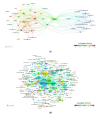A Bibliometric Review of Artificial Extracellular Matrices Based on Tissue Engineering Technology Literature: 1990 through 2019
- PMID: 32605069
- PMCID: PMC7372414
- DOI: 10.3390/ma13132891
A Bibliometric Review of Artificial Extracellular Matrices Based on Tissue Engineering Technology Literature: 1990 through 2019
Abstract
Artificial extracellular matrices (aECMs) are an extension of biomaterials that were developed as in-vitro model environments for tissue cells that mimic the native in vivo target tissues' structure. This bibliometric analysis evaluated the research productivity regarding aECM based on tissue engineering technology. The Web of Science citation index was examined for articles published from 1990 through 2019 using three distinct aECM‑related topic sets. Data were also visualized using network analyses (VOSviewer). Terms related to in-vitro, scaffolds, collagen, hydrogels, and differentiation were reoccurring in the aECM‑related literature over time. Publications with terms related to a clinical direction (wound healing, stem cells, artificial skin, in‑vivo, and bone regeneration) have steadily increased, as have the number of countries and institutions involved in the artificial extracellular matrix. As progress with 3D scaffolds continues to advance, it will become the most promising technology to provide a therapeutic option to repair or replace damaged tissue.
Keywords: artificial extracellular matrix; biomaterials; regeneration; tissue engineering.
Conflict of interest statement
The authors declare no conflict of interest. The funders had no role in the design of the study; in the collection, analyses, or interpretation of data; in the writing of the manuscript, or in the decision to publish the results.
Figures




References
-
- Naveau A., Smirani R., Catros S., De Oliveira H., Fricain J.-C., Devillard R. A Bibliometric Study to Assess Bioprinting Evolution. Appl. Sci. 2017;7:1331. doi: 10.3390/app7121331. - DOI
-
- Park J., Lakes R.S. Biomaterials: An Introduction. 3rd ed. Springer; Berlin, Germany: 2007. pp. 1–561.
Publication types
Grants and funding
LinkOut - more resources
Full Text Sources
Research Materials

